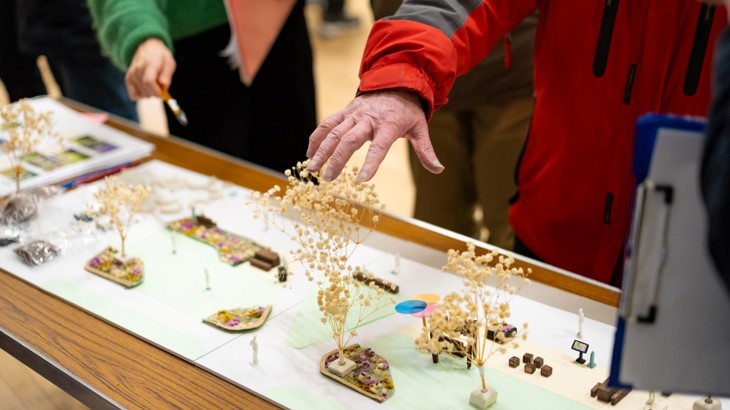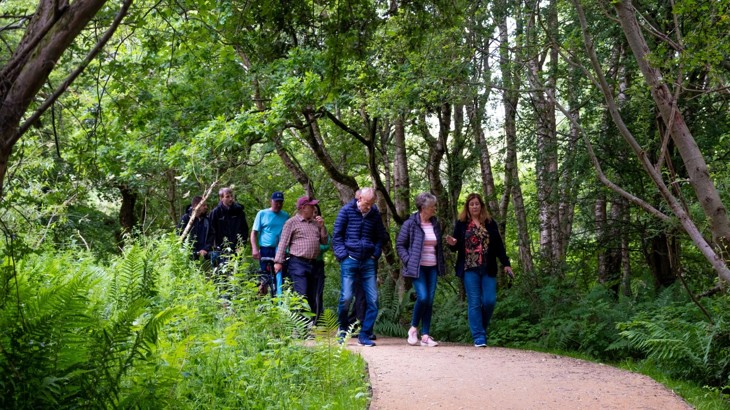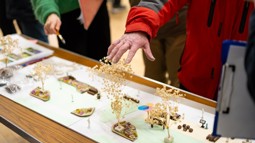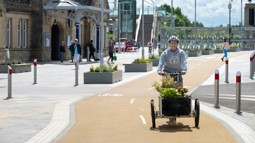Our latest research from Scotland explores experiences of community-led active travel infrastructure projects, and how we can enable more community groups to improve their local area for walking, wheeling and cycling.

With design decisions in the hands of the community, projects can reap innovative results that work for local people. Credit: Michael Kelly.
Engaging with local communities is key to the success of any active travel infrastructure project.
Across our projects up and down the country, we work with community members who are passionate about improving their local area for walking, wheeling and cycling.
More and more, communities across Scotland are showing a willingness to take more ownership of these issues.
Although there is no single definition of what makes something ‘community-led’, often it involves community members securing funding, problem solving and maintaining decision-making power throughout a project.
For this piece of research, we set out to gain a better understanding of this process, what the common obstacles are, and what benefits can come from a project being driven by the local community.
As well as a literature review, we conducted 9 interviews with active travel professionals and community group members.
We also carried out an online survey targeted at individuals who have taken part in a community-led infrastructure project as a community group member.
Perspectives from community members and active travel professionals
Amongst a range of shared issues and experiences, our research showed that success often relies on partnership.
Strong partnerships with local councils and active travel organisations can help community groups bridge skill gaps, manage risks and navigate bureaucratic issues.
The luxury of time is also a factor. Longer-term projects are generally preferred by communities, as they allow for collaboration, flexible problem solving and help manage fluctuations in resources.
However, maintaining momentum and direction during longer projects can be difficult for community groups.

Community groups rely on accessible funding and support from expert organisations. Credit: Michael Kelly.
Community projects also rely on financial security. Access to flexible funding with multi-year budgets and upfront financing are invaluable.
In the current funding landscape, community groups are required to navigate multiple complex and competitive application processes with quick-turn arounds - and this creates barriers for them.
Alongside this, the success of a community-led project can often rely on skilled, motivated and time-rich community members.
This over-reliance can be precarious. But it also reflects issues to do with equity.
Barriers to participation mean that wealthier communities, with more time, education and resources often dominate funding applications.
Recommendations from the research: funding, partnership, equity, evidence
From this research, we were able to come up with a number of recommendations for funders and active travel organisations to more easily facilitate community-led projects.
Funding:
Simplify and standardise funding application processes to make them more accessible to community groups.
Make multi-year, upfront and sizable funding available to community-groups.
Partnership working:
Retain a focus on partnership approaches to community-led infrastructure, whilst ensuring they don’t detract from communities’ control.
This could be done by ensuring:
-
communities have self-determination over the structure of partnerships and how partners are involved
-
partnerships focus on upskilling, empowering and supporting with technical challenges
-
a focus on relationship building between partners.
Equity:
Understand patterns of where community-led projects are being funded currently, from an equity perspective.
Co-design more equitable models of community-led infrastructure development that overcome practical, personal, socio-economic and motivational barriers to participation by community members.
Monitoring & Evaluation:
Develop criteria for what constitutes ‘community-led’.
Carry out standardised monitoring and evaluation of community-led projects to build an evidence base.

Friends of Monklands Canal community group is heavily involved in local active travel projects, like this new woodland link to National Cycle Network Route 75. Credit: Michael Kelly.
Our research showed that a community-led approach to infrastructure delivery can help to create schemes that communities feel ownership over and that meet their specific needs.
This leads to better usage, less resistance and continued maintenance.
If done well, the community-led approach empowers and upskills communities to tackle and advocate for further changes.
With support from funders and partners to address some of the key common issues, we could see more successful community-led projects across Scotland – making it possible for more and more people to walk, wheel and cycle.





